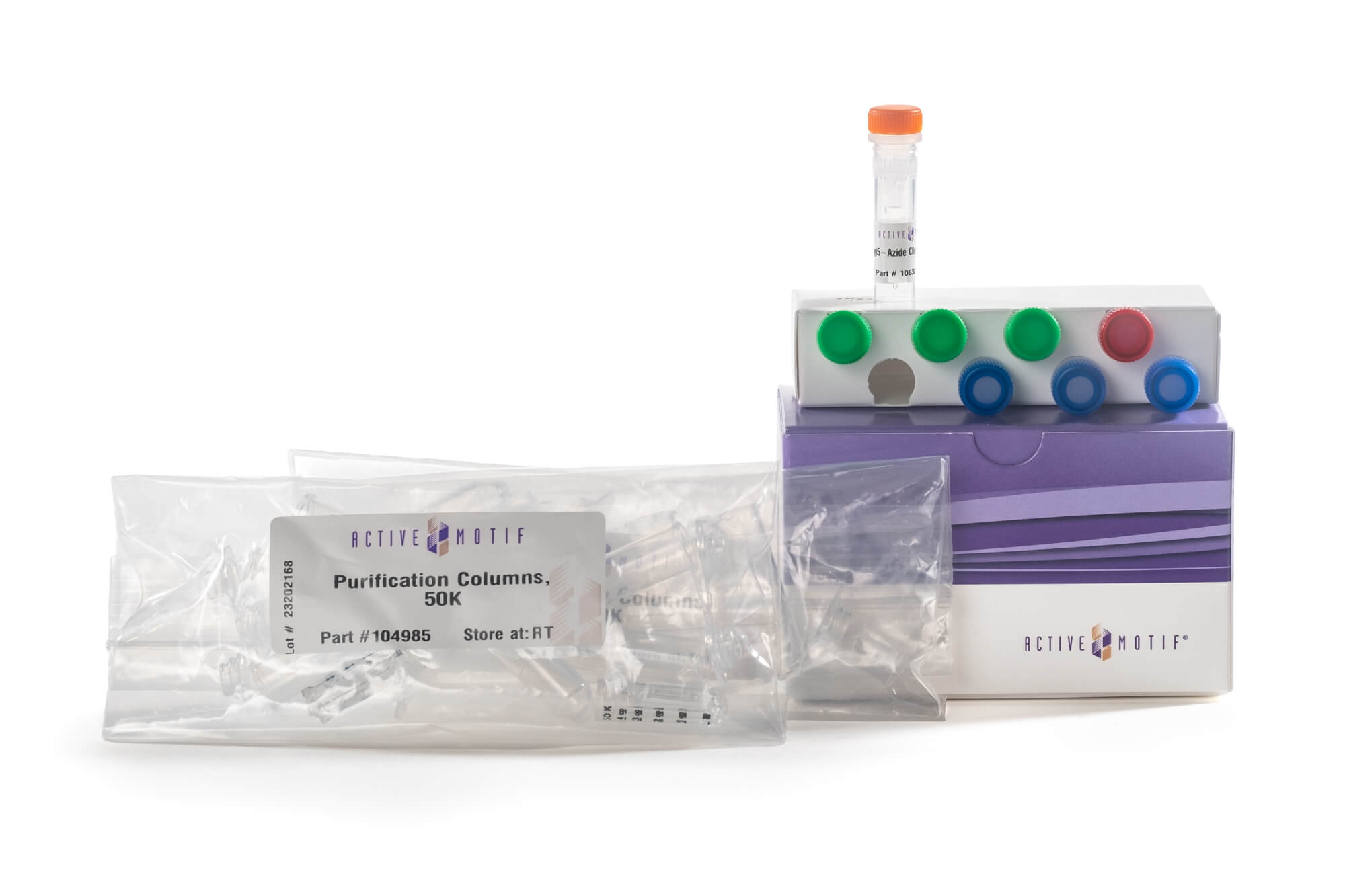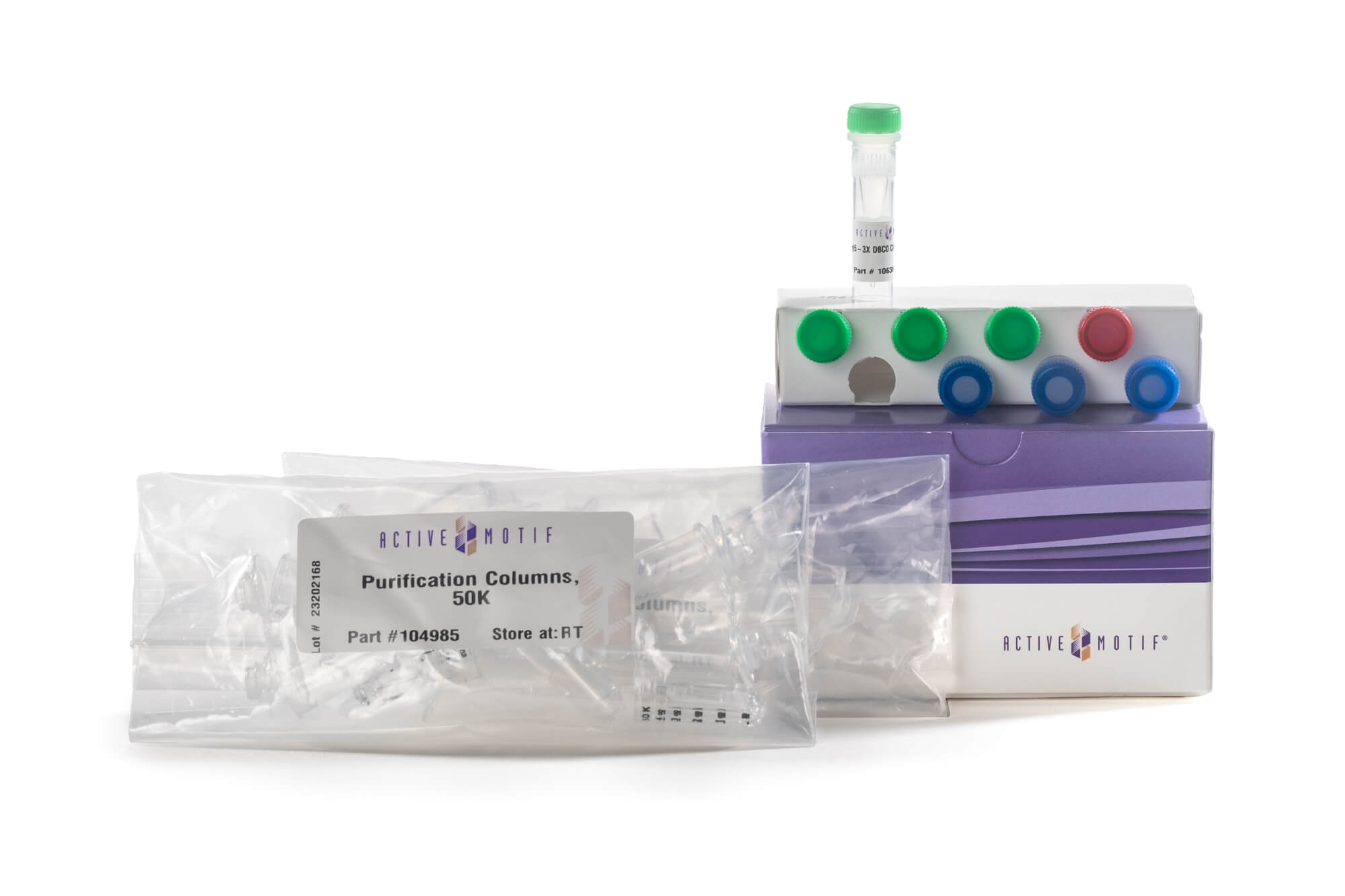Sortag-IT™ Click Chemistry Kit Overview
Sortag-IT™ Labeling Kits are designed for site-specific labeling of Active Motif's highly specific AbFlex® recombinant antibodies (rAb) via the Sortase tag recognition sequence (LPXTG) that is incorporated into the heavy chains of each AbFlex antibody. Directly conjugate fluorophores, enzymes (HRP, AP), biotin, peptides, DNA, carbohydrates, or other labels to the terminal end of the heavy chain to ensure the antigen binding site remains available for target recognition.
Sortag-IT™ Labeling Kit and Sortase A5 Labeling Scheme

Sortase A belongs to a family of transpeptidases found in Gram-positive bacteria that catalyze the attachment of poly-Glycine (G)n labels to the sortase recognition sequence. The Sortag-IT Labeling Kits use Active Motif's Sortase A5 pentamutant from Staphylococcus aureus that is significantly more active than wild-type Sortase to provide a faster, more efficient labeling reaction. Each antibody contains two Sortase tag sequences. The conjugation occurs on both heavy chains. Only one side is shown for simplicity. Simply add your AbFlex antibody with the poly-Glycine label, add Sortase A5 and incubate for approximately 1 hour. Purification columns are included to remove excess label and Stop Solution is provided to inactivate the Sortase A5 enzyme. Labeled antibodies are ready for downstream analysis or can be stored at 4°C for up to 3 months.
The Advantages of Click Chemistry
- Ease of use and quick reaction time
- Commercial availability of a multitude of click chemistry compatible labels
- Formulated to allow up to 6 conjugations per antibody (kit dependent)
- Physiological reaction conditions are compatible with a wide variety of conjugates
Active Motif’s latest advance in sortase mediated conjugation incorporates click chemistry, resulting in simplified conjugations and more conjugates per antibody. Click chemistry is a simplified approach for covalently linking two molecules in a simple room temperature reaction under standard buffer conditions. Learn more about click chemistry here.
Active Motif’s new Sortag- IT™ conjugation kits now incorporate click chemistry resulting in simplified conjugations and more conjugates per antibody. The first step in the process is the enzymatic sortase reaction, that adds a click chemistry compatible linker to the Abflex antibody via the sortag recognition sequence. The available kits contain linkers with either dibenzocyclooctyne (DBCO) or an Azide group as click chemistry components. Once the linkers are added, the conjugation is completed by a spontaneous click chemistry reaction with a DBCO or Azide labeled molecule of your choice1. These labeled molecules are readily available from multiple vendors.
The selective click chemistry reaction of an Azide group on the donor molecule and a DBCO on the acceptor molecule is shown below. The covalent reaction, achieved by simply mixing the two components, yields a stable conjugate also known as a triazole linkage 2.
Click Chemistry Reaction Schematic

The Sortag-IT Click Chemistry kits are available in three varieties
1. Sortag-IT™ Azide Click Labeling Kit, contains a linker with the polyglycine sortase attachment site on one end and an Azide group on the other. This kit enables click chemistry mediated conjugation to biomolecules containing a DBCO group. Antibody conjugation with this kit results in the attachment of up to 2 molecules per antibody.

2. Sortag-IT™ DBCO Click Labeling Kit contains a linker with the polyglycine sortase attachment site on one end and one DBCO group on the other. This kit enables click chemistry mediated conjugation to biomolecules containing an Azide group. Antibody conjugation with this kit results in the attachment of up to 2 molecules per antibody.

3. Sortag-IT™ 3X DBCO Click Labeling Kit contains a linker with the polyglycine sortase attachment site on one end and three DBCO groups on the other. This kit enables click chemistry mediated conjugation to biomolecules containing an Azide group. Antibody conjugation with this kit results in the attachment of up to 6 molecules per antibody.

The Sortag-IT™ Click Labeled AbFlex® antibodies can be purified and used in multiple downstream applications due their click chemistry compatibility with DBCO or Azide labeled molecules.

Sortag-IT™ Click Chemistry Kit Contents
Each Sortag- IT™ click chemistry kit is shipped on dry ice and contains reagents requiring multiple storage temperatures. Please confirm receipt of all reagents upon arrival and store items at the appropriate temperatures as indicated below. The kit is guaranteed for 6 months when all components are stored properly.
| Reagents | Quantity | Storage |
|---|---|---|
| Sortase A5 enzyme | 12 units (3 tubes) | -80°C |
| Reaction Buffer AM3 | 3.2 mL (3 tubes) | 4°C |
| (Gly)5- Click label | 24 µl | -20°C |
| Stop Solution AM3 | 8 µl | RT |
| Purification columns | 2 bags (3 columns per bag) | RT |
Sortag-IT™ Click Chemistry Kit Data

Figure 1: AbFlex® H3K27ac antibody (rAb) conjugated to DNA using Active Motif’s Azide click label.
AbFlex® H3K27ac antibody (rAb) (Cat. No. 91193) was first labeled with Sortag-IT™ Azide Click Labeling Kit (Cat. No. 13114). Then 20 pmol of azide labeled antibody was mixed with 400 pmol of 70-mer oligonucleotide bearing a DBCO group and incubated at 4 °C overnight. The samples were loaded onto a 4-12% SDS-PAGE and stained with Coomassie blue.
Lane1: AbFlex® H3K27ac unlabeled control antibody.
Lane 2: AbFlex® H3K27ac Azide labeled antibody (rAb) conjugated to a 70-mer oligonucleotide.
The red arrow shows the antibody with 1 oligonucleotide conjugated.
The blue arrow shows the antibody with 2 oligonucleotides conjugated.

Figure 2: AbFlex® CTCF antibody (rAb) conjugated to DNA using Active Motif’s DBCO click label.
AbFlex® CTCF antibody (rAb) (Cat. No. 91285) was labeled with Sortag-IT™ DBCO Click Labeling Kit (AM Cat. No. 13115) or Sortag-IT™ 3X DBCO Click Labeling Kit (Cat. No. 13116). Then 20 pmol of DBCO labeled antibody was mixed with 400 pmol of 70-mer oligonucleotide bearing an azide group and incubated at 4°C overnight. The samples were loaded onto a 4-12% SDS-PAGE and stained with Coomassie blue.
Lane1: AbFlex® CTCF unlabeled control antibody.
Lane 2: AbFlex® CTCF antibody (rAb) DBCO labeled and conjugated to a 70- oligonucleotide.
Lane 3: AbFlex® CTCF antibody (rAb) 3X DBCO labeled and conjugated to a 70- oligonucleotide.
The red arrow shows the antibody with 1 oligonucleotide conjugated.
The blue arrow shows the antibody with 2 oligonucleotides conjugated.
The green arrow shows the antibody with 3 oligonucleotides conjugated.
The yellow arrow shows the antibody with 4 oligonucleotides conjugated.
Sortag-IT™ Click Chemistry Kit Documents
You might also be interested in:
References:
1. Zeglis, Brian M., and Jason S. Lewis. "Click for Better Chemistry." The New England Journal of Medicine, 15 Dec. 2022, pp. 2291-93.
2. Zayas, Jessica, et al. "Strain Promoted Click Chemistry of 2- or 8-Azidopurine and 5-Azidopyrimidine Nucleoside and 8-Azidoadenosine Triphosphate with Cyclooctynes. Application to Living Cell Fluorescent Imaging." National Library of Medicine, pp. 1519-32, https://doi.org/https://www.ncbi.nlm.nih.gov/pmc/articles/PMC4826778/.
| Name | Format | Cat No. | Price | |
|---|---|---|---|---|
| Sortag-IT™ Azide Click Labeling Kit | 3 x 100 µg | 13114 | $360 | Buy |
| Sortag-IT™ DBCO Click Labeling Kit | 3 x 100 µg | 13115 | $360 | Buy |
| Sortag-IT™ 3X DBCO Click Labeling Kit | 3 x 100 µg | 13116 | $405 | Buy |
| Sortag-IT™ HRP Labeling Kit | 3 x 100 µg | 13104 | $360 | Buy |
| Sortag-IT™ Biotin Labeling Kit | 3 x 100 µg | 13105 | $360 | Buy |
| Sortag-IT™ ATTO 488 Labeling Kit | 3 x 100 µg | 13107 | $360 | Buy |
| Sortag-IT™ ATTO 532 Labeling Kit | 3 x 100 µg | 13108 | $360 | Buy |
| Sortag-IT™ ATTO 550 Labeling Kit | 3 x 100 µg | 13109 | $360 | Buy |
| Sortag-IT™ ATTO 647N Labeling Kit | 3 x 100 µg | 13110 | $360 | Buy |
| Sortag-IT™ HRV 3C-Biotin Labeling Kit | 3 x 100 µg | 13111 | $405 | Buy |
Sortag-IT™ Labeling Kit Highlights
- Site-specific antibody conjugation ensures the antigen binding site is always available post-labeling; No need to re-validate the antibody
- Directed labeling eliminates the need for secondary antibodies which saves valuable time and avoids anti-species restrictions in secondary antibody selection
- Easily attach any poly-glycine label to the Sortase recognition motif (LPXTG)
- Sortase A5 pentamutant is more active and efficient than wild-type Sortase; Label the antibody in about 1 hour
- Includes purification reagents
How Does it Work?

The Sortag-IT™ Labeling Kit for AbFlex® recombinant antibodies
The Sortag-IT Labeling Kits should be used in combination with Active Motif's AbFlex recombinant antibodies. Each AbFlex antibody contains a Sortase tag sequence on the terminal end of each heavy chain for site-specific addition of up to two maximum labels per antibody molecule (two is the theoretical maximum number of labels that can be added to each antibody, however, steric hindrance may prohibit the addition of 2 labels depending on the label used).
First, combine the Ablex recombinant antibody with the desired poly-Glycine label in the presence of Sortase A5 enzyme and Ca2+-based reaction buffer. Next, Sortase A5 will bring the poly-Glycine label to the Sortase recognition motif (LPXTG) on the antibody. Then, Sortase A5 will cleave the bond between the Threonine and the Glycine in the LPXTG sequence creating an acyl enzyme intermediate which allows for the attachment of the poly-Glycine label. Finally, the labeled AbFlex antibody is purified away from the free label and the Sortase A5 enzyme is inactivated with Stop Solution.
Validation
Each Sortag-IT Labeling Kit is validated in a functional assay to confirm the presence of the label. Data is provided on the data sheet for each specific kit. Below is an example of the Sortag-IT™ HRP Labeling Kit used to directly conjugate 100 µg of Active Motif's AbFlex® Histone H3K9ac recombinant antibody with HRP.

Figure 1: Western blot of Sortag-IT labeled Histone H3K9ac-HRP antibody.
Eight µg sodium butyrate treated HeLa acid extract (Lane 1) and 8 µg untreated HeLa acid extract (Lane 2) were run on a 4-12% SDS-PAGE gel at 150V for 1.5 hours. Material was transferred to a nitrocellulose membrane and blocked with TBST containing 5% milk. Then, 1 µg/µl Histone H3K9ac-HRP conjugated antibody was added for 1 hour at room temperature. The blot was washed three times with TBST and developed with Bio-Rad Clarity.
Contents & Storage
Each Sortag-IT Labeling Kit provides sufficient material to label 3 x 100 µg AbFlex® recombinant antibody with a yield >50%.
- 3 units Sortase A5 enzyme; Store at -80°C
- 1 ml Reaction Buffer AM3: Store at 4°C
- (Gly)5-Label; Store at varies
- 10 µl Stop Solution AM3; Store at RT
- 3 ea Purification Columns; Store at RT




